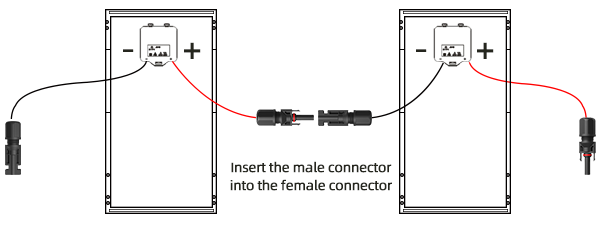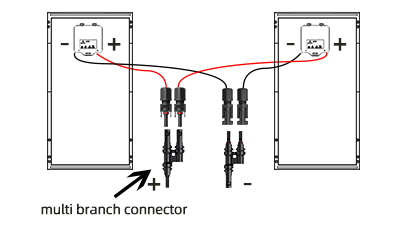How to Use the MC-4 Connector and Solar Extension Cable
What are solar MC-4 connectors (male and female) and solar extension wires? Most modern high wattage solar module modules are manufactured with wires that end with solar connectors. Years ago, solar modules had a junction box on the back that required installers to manually connect wires to the positive and negative terminals. This method is still used, but it is slowly becoming a thing of the past. Modern solar modules tend to use solar connectors because they make wiring the solar array easier and faster. Solar Connectors come in both male and female types and are designed to snap together. They meet the requirements of the National Electrical Code, are TUV certified and are the preferred connection method for electrical inspectors. Since the solar cable connectors are locking, they won't unplug, making them ideal for outdoor environments. The connectors can be separated, but a special MC-4 unlocking tool is required.
Connecting MC4-equipped modules in series: If you have two or more solar modules connected in series, the MC-4 connector makes it really easy. Take a look at the first module and you'll notice that it has two wires extending from the junction box. One wire is DC positive (+) and the other is DC negative (-). Typically, the female connector is connected to the positive lead and the male connector is connected to the negative lead. This may not always be the case, so it's best to look at the markings on the junction box or test polarity with a digital voltmeter. Series connection refers to connecting modules together by connecting the positive lead on one module to the negative lead on another module. The male connector will snap directly into the female connector. Below is a simple diagram to illustrate this.

Parallel connection of MC4-equipped modules: Parallel wiring requires the positive leads to be connected together and the negative leads to be connected together. This method will increase the current at maximum power (Imp) while keeping the voltage constant. For example, suppose your module is rated at 8A and 18V. If two of them were connected in parallel, the total current would be 16 A, and the voltage would remain at 18V. When connecting two or more modules in parallel, you will need some additional equipment. If you are only using two modules, the easiest way is to use MC-4 multi-branch connectors. You obviously can't wire two male connectors or two female connectors together, so we use multi-branch connectors to do that. There are two different types of multi-drop connectors. One type accepts two male MC-4 connectors on the input side and has one male MC-4 connector on its output. Another type accepts two female MC-4 connectors and provides one female MC-4 connector for its output. Essentially, you've reduced the number of wires from two positive and two negative to one positive and one negative. Here's a diagram so you can see what it's doing.

If you are paralleling more than two modules, or if you are paralleling multiple strings of modules, you will need a device called a PV combiner box. You no longer need a multi-drop connector as the combiner box will perform the same function. Multi-drop connectors are only suitable for connecting two modules together in parallel. A combiner box is used if more than two modules or strings need to be connected in parallel. The total number of modules that can be combined will depend on the electrical rating and physical size of the combiner box. Whether you're combining modules with multi-drop connectors or combiner boxes, you need to know how to select and use MC-4 extension cables.
What Are Solar Extension Cable And How Do You Use?
If you have never used a solar cable before and don't know how to use it, or purchased the cable and then found the length was too short after cutting it. Cut cables cannot be returned, so we want to make sure you fully understand how to choose the proper length and use them to connect panels together.
Solar extension cables are very similar in concept to electrical extension cords. Just like an extension cord has a male plug on one end and a female plug on the other, a solar extension cables has a male connector on one end and a female connector on the other. They come in many different lengths ranging from 8 feet to 100 feet. Let's go back to our first example of connecting two modules in series. After connecting the two modules in series, you need to use solar cables to deliver power to wherever the electrical equipment is located (usually circuit breakers and solar charge controllers). Systems using two modules are often used in RVs and boats, so you can usually use extension cables the entire distance. When you're using solar panels on a house or cottage, the distance the wires have to travel is often so long that using extension cables is no longer practical. In these cases, extension cables are used to connect the panels to the combiner box. This way, you can use cheaper wiring (such as THHN wire) inside the electrical conduit to cover greater distances at a much lower cost than solar cables.
Assume the total length of wire required from the two modules to your electrical equipment is 20 feet. All you need is an extension cord. We offer a 50 feet extension cord that is perfect for this situation. Remember that the two solar modules you have connected together have a positive lead with a male MC-4 connector and a female lead with a female MC-4 connector. To transmit a distance of 20 feet to your device, you will need a 20-foot cord with a male connector and a 20-foot cord with a female connector. This is accomplished by cutting the 50-feet extension cable in half. This will give you one 25 feet cord with a male connector and one 25 feet cord with a female connector. This allows you to plug in both leads from the solar panel and gives you enough wire to get to your destination. Sometimes cutting a cable in half isn't always the best solution. Depending on the location of the combiner box, the distance from one side of the panel string to the combiner box may be greater than the distance from the other side of the panel string to the combiner box. In this case, you'll need to cut the extension wire at a point that allows the two cut ends to reach the combiner box, with a little slack.
For systems using combiner boxes, you simply select a length that is sufficient to terminate in the combiner box when cut. You can then strip the insulation from the cut ends and terminate them to bus bars or circuit breakers.
Disconnect MC-4 Solar Connector Tool
This is a connector spanner wrench tool. If for some reason you need to disconnect the solar cables, you will need one of these. You must insert the two extension posts on the end of the wrench into the side of the female MC-4 connector. This disengages the locking mechanism on the male connector and allows the two connectors to separate. You can also use it if you need to install a connector.
If you have any questions about solar connectors, T/Y branch connectors, extension cables, please call or email us. The Kuka Cable team will be happy to assist you.





